How to make a potbelly stove on waste oil with your own hands: a review of the best homemade products
When any mechanisms are used, technical oils are used. When used for their intended purpose, they are not burned and retain flammability. Instead of recycling, an alternative option for their reuse is a waste oil stove, which you can make yourself.
Let's try to figure out how a potbelly stove works and what materials will be required for its manufacture. We will also talk about popular models of homemade stoves and share the secrets of their successful operation.
The content of the article:
- The principle of operation of the potbelly stove
- Making a simple do-it-yourself stove
- Creating a stove gas stove from a gas cylinder
- Potbelly stove plus water circuit
- Drip potbelly stove working out
- Alteration of solid fuel potbelly stove for mining
- The secrets of the successful operation of the stove
- Conclusions and useful video on the topic
The principle of operation of the potbelly stove
The work of a potbelly stove is based on the phenomenon of pyrolysis. In such a furnace, where the oil is used as fuel, there are 2 main compartments: a tank and a combustion chamber located at different levels. The first is designed to fill the mining and its combustion.
In the other compartment located above, the combustion products of the mining mixed with air are burned. At the first stage, the temperature is relatively moderate, and at the second, much higher - up to 800⁰.
In the manufacture of such a furnace, the main task is to make sure that air enters both compartments. It enters the first chamber through an opening intended for loading liquid fuel. The hole is equipped with a special shutter, through which the volume of air is regulated.
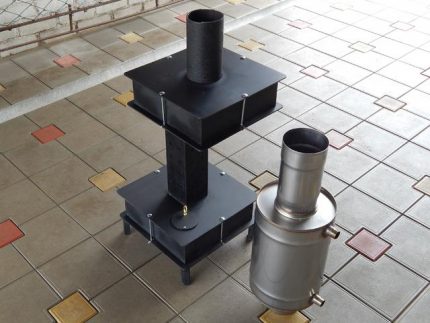
Air inlet into the second tank is provided by openings with a diameter of about 9 mm.The efficiency of a correctly assembled potbelly stove reaches 90%. Visually different potbelly stoves can differ from each other both in shape and size, but the principle of operation is the same.
The power of the potbelly stove is proportional to the volume of the lower tank. The more voluminous it is, the less often you will have to add mining. Sometimes this container is made very massive, containing about 30 liters of used oil.
Improvement of the simple design of the stove at workout made it possible to invent a unit for arranging a garage in which it would be nice to wash your hands with hot water, or a small private bathhouse:
Making a simple do-it-yourself stove
The basic design of a self-made potbelly stove consists of 4 parts:
- Fuel tank arbitrary shape with a hole in the center, the diameter of which is equal to the corresponding size of the connected pipe. This is where mining starts. The metal for the manufacture of this structural element must have a thickness of at least 3 mm.
- Combustion chambers or an injector, which is a vertical cylindrical container with a series of holes attached through an opening to the tank. As a result of recharge of air through the perforated walls of the injector, the fuel entering the chamber burns completely.
- Heat exchanger in the form of a tank located above the combustion chamber. The heated gas mixture enters it. The design can have any size and shape. Ideally, this is a tank with a hollow platform where you can heat food.
- Smoke exhaust pipesproviding effective traction.
To make a potbelly stove yourself you need to have good welder skills. Welds must ensure tightness.
Production tank for mining
An alternative to a welded tank can be an unusable gas cylinder or a canister with thick walls, but in any case 3 basic requirements are mandatory:
- The design must be at least partially collapsible for the possibility of its periodic cleaning.
- The hole for connecting the injector must be centered.
- The filling hatch should be equipped with an adjusting flap on the bolted joint. With its help regulate the intensity of combustion.
It is easiest to make a tank from pipes of large diameter. A bottom and legs are welded to one piece of pipe with a diameter of about 35 cm. In order to close the tank, take a small piece of pipe of a slightly larger diameter, weld a lid to it, then make 2 holes in it - one control with a diameter of approximately 60 mm, and the other under the injector.
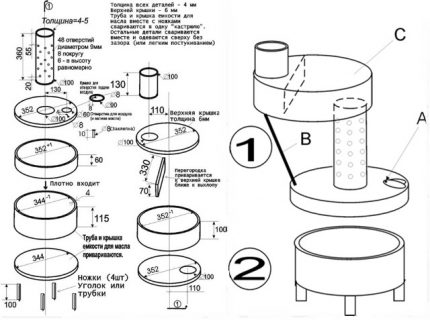
The height of the side 2 of the part should be 1/3 of the height of the lower tank. The total height of the tank, measured from its bottom to the central hole on the lid, is 10-15 cm.
Kindle fuel in the tank using paper or cloth soaked in kerosene. They are set on fire and lowered into a container through a control hole.Workout will have to be constantly added to maintain a level of 2/3 of the tank height.
How to make an injector?
The optimum diameter of the pipe for the manufacture of the injector is 10 cm, the minimum wall thickness is 0.8 cm. To calculate its height, take the length of the chimney pipe, divide it by 10. Five percent is subtracted from the result and the desired value is obtained. It should be between 36 - 38 cm. This is a condition for normal traction.
The holes made in the walls of the pipe in a checkerboard pattern or simply evenly distributed over the surface have a diameter of 0.9 - 0.95 cm. Indentations from the bottom and top of the pipe are 2 - 2.5 cm and 5.5 - 6 cm, respectively.
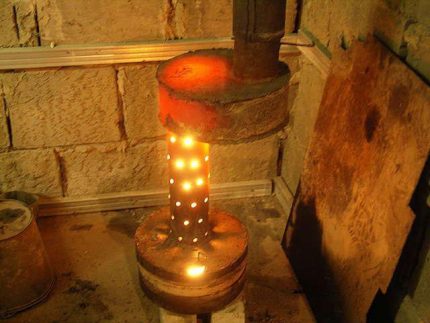
Basic heat exchanger
The minimum wall thickness of the heat transfer tank is 0.3 cm. It is made using the same technology as the fuel tank. It is better to make the top flat, and the hole for the chimney should be shifted, then it will be possible, if necessary, to put a frying pan or kettle on the stove.
A partition is made inside the hollow vessel, creating a maze for better heat transfer. At the same time, the thicker this part, the hotter the surface of the stove-stove. In order to clean the heat exchanger from soot, make a special hatch on the side and close it with a lid.
On the hole intended for the chimney, a channel is welded - a pipe with a height of 5 to 10 cm and a diameter of 10 cm.
What to make a chimney from?
In order for the combustion products leaving the pipe to have a temperature as low as possible, the part of the pipe that is in the room must be made of steel. Due to this, the smoke gives its temperature to the walls of the chimney, cools, increasing the residual heat transfer.
An ordinary chimney pipe can serve as a continuation of the chimney outside, but it will have to be insulated to prevent the accumulation of soot in the cold period. A thermally insulated pipe is the best option, but more expensive. Joints of pipe sections are not necessary to seal.
Photo instruction for independent masters
The manufacture of a working stove, which we will consider in the example, was carried out in accordance with the drawing below. Cutting of sheet steel was performed in advance on a machine with a guillotine. A turner drilled 54 holes in the pipe.
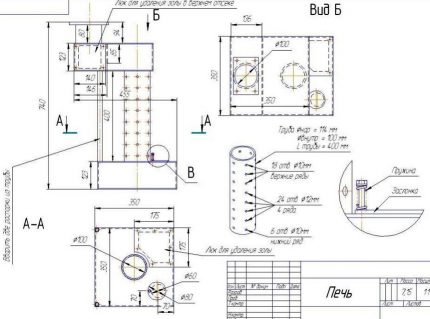
The manufacturing process of the stove itself consists in connecting the workpieces by welding and assembly of the unit, it includes a number of standard steps:
All of these actions were aimed at manufacturing the structural parts of the potbelly stove, which now will simply need to be assembled:
The pipes themselves can be of different diameters, but the one with the smaller diameter is connected directly to the furnace. And about how to make a chimney for a stove yourself, read Further.
Creating a stove gas stove from a gas cylinder
Another version of the design of the kiln for testing is a self-made potbelly stove based on a 50-liter gas cylinder. In addition to this basic element, it is necessary to prepare 2 steel pipes with a wall of about 4 mm and a diameter of 10 cm. One of them will remove burning gases, and the second will act as a heat exchanger.
To this should be added a 4 mm steel sheet for the visor above the heat exchanger and the partition separating the evaporator and the combustion chamber. For the evaporation chamber itself, you need a brake disc from a car with a diameter so that it effortlessly enters the cylinder. A piece of 0.5-inch pipe is needed to transport oil to the combustion chamber.
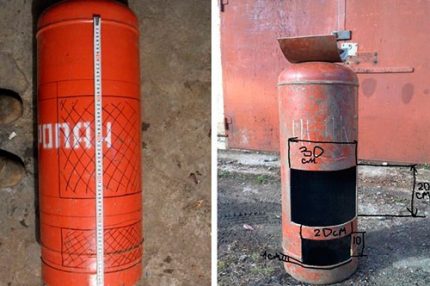
In addition, you should have in stock an equilateral steel corner with a shelf of 50 mm and a length of more than 1 m, a 0.5-inch valve, clamps for sealing - 2 pcs., A hose, any cylinder equipped with a needle valve.
Work on the creation of potbelly stoves is carried out in a specific order. First, the cylinder is turned upside down and a small hole is drilled in it.A measure such as wetting the drill bit and the drilling site with oil will protect against sparking.
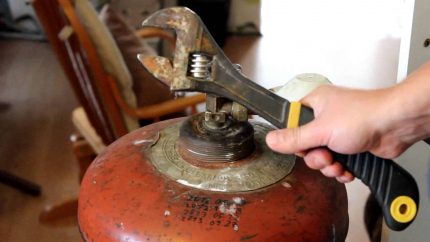
Free the tank from gas condensate. It is carefully drained away from the housing, as its unpleasant odor persists for a long time. Then the preform is filled with water, after which it is again drained, thus removing the remaining gas. Since the mixture is explosive, there should be no open flame nearby.
Cut out in the container body 2 rectangles of the same width equal to 1/3 of the diameter of the workpiece. The height of the lower rectangle is 20 cm, the second one located 5 cm higher than the first, 40 cm. To separate the chambers, a circle with a diameter equal to the inner diameter of the vessel is cut out of the sheet.
In its middle, make a hole for a pipe with a diameter of 10 cm. This part will separate the combustion chamber from the heat exchanger.
A burner is made from a pipe with a length of 20 and a diameter of 10 cm. The lower part is perforated by making holes with a diameter of about 2 cm. They clean the inside of the burrs, otherwise they will collect soot on themselves, which will significantly narrow the hole later.
A previously cut circle is put on the burner, positioning it exactly in the middle, welded. The design is placed inside the stove and a weld is made around the circumference of the cylinder.
They weld the bottom and cover onto the brake disc. It will be a pan or evaporator bowl. To supply fuel in the lid leave an opening through which air will flow into the potbelly stove. The opening is made quite wide, otherwise the draft will decrease, and the oil will not fall into the bowl.
Weld the pipe to the top of the lid. A sleeve is made from a pipe with a diameter of 10 cm, which will connect the bowl to the burner.
Assemble the fuel supply system, for which:
- make a receiving hole in the pallet;
- insert a 0.5-inch length of water pipe into it at an angle of about 40 °;
- weld the pipe to the furnace body;
- an emergency backup valve is screwed to the pipe, the role of which is played by an ordinary water tap.
A heat exchanger is made from a pipe with a cross-section of 10 cm. It is cut horizontally into the potbelly stove case, and a reflector is mounted at the end. Arrange blowing by installing a duct fan at the end of the heat exchanger. Air driven through the heat exchanger with its help has a high speed.
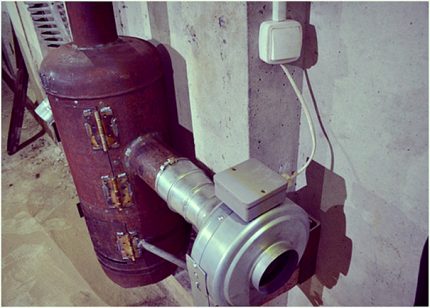
An air swirl consisting of triangular teeth connected by welding is placed inside the heat exchanger. A chimney is made from a pipe with a cross section of 10 cm.
It is welded into the hole located in the upper part of the furnace body and led out through the wall to the roof of the building.
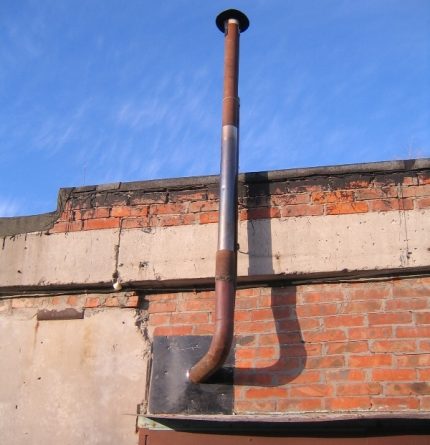
Next, they make the oil tank. If there is a freon-free cylinder with a working needle valve, then it is quite suitable for this purpose. The vessel and the stove-stove are connected by a hose connected to the valve. A hole is made in the tank body to fill the used oil.
To ensure air access to the burner and the evaporator bowl, a groove is selected in the lower compartment door. Thrust plates are attached to the opening of the upper chamber door, which ensures reliable sealing of the combustion chamber. For the same purpose, the door is additionally equipped with a lock.
Now, even if the stove case is deformed as a result of strong heating, the tightness of the combustion chamber will not be violated.
It remains to weld the legs from the corners to the body and put the oven upright. In addition to bourgeois in vertical design, horizontally located stoves. Their device is similar.
Potbelly stove plus water circuit
An emergency heat source will not hinder any home. An ordinary, but slightly modernized, potbelly stove may play its role. There are two ways to improve the furnace: put a water jacket on the burner tube or wrap its body with a coil of copper tubes.
The coils of the coil are placed at a distance of about 5 cm from the perforated body of the potbelly stove and connected to a common heating system. Around the coil install a reflective screen. For its manufacture, sheet aluminum, galvanized steel, and tin are used.
A water shirt is a tank on the upper chamber of a potbelly stove. There should be 2 fittings in its body - one for supply and one for water drainage. In general, the design resembles a samovar. The volume of the water jacket depends on the length of the heating system and the method of circulation of the coolant.
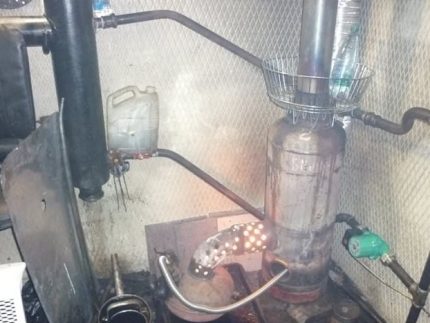
If a pump is mounted in the system, the volume of the tank is small, and with natural circulation it has impressive dimensions. To control the parameters of water, a pressure gauge and a thermometer are installed on the tank.
Drip potbelly stove working out
You can also make an economical model of a drip potbelly stove yourself. For the case, a metal barrel of a small volume or another tank available on the farm is suitable. A hole is made in the housing through which oil will flow.
Next, take a burner with a capacity of about 2 l, connect a copper pipe 1 m long to its hose, and then fold it in half.
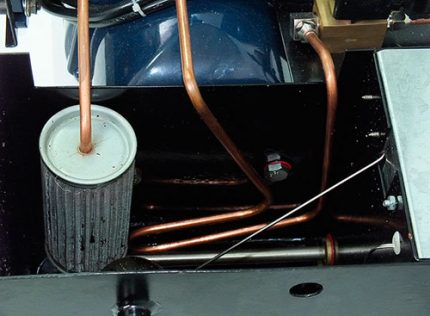
A hole is made in the container along the diameter of the tube. The tube itself is shaped like the letter “G”, and the burner is suspended.
Alteration of solid fuel potbelly stove for mining
When there is already a potbelly stove in the household, but it does not suit the fact that it runs on solid fuel, it is possible to modernize it and it will become universal. For this, a prefix is made that resembles in its design a stove for processing in its lower part.
Here, too, there is a perforated pipe, but not a straight one, but bent at a right angle. It is connected to the side wall of the furnace, which acts as the final combustion chamber. If you weld the door of the potbelly stove and make a hole in it for the pipe to enter, then the furnace will only work on working off.
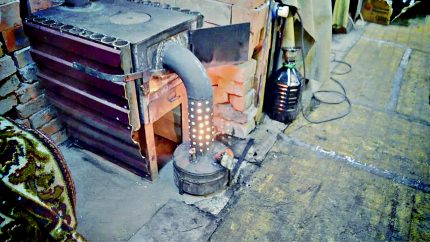
In order to be able to use not only technical oil, but also firewood for heating, two removable doors are made. The standard one is hung when it is planned to lay firewood, and the modernized one with the corresponding hole - when the stove will operate on used oil.
We also offer to read an article on how to collect a potbelly stove on waste oil from a pipe - to familiarize yourself with the material, go to the link.
The secrets of the successful operation of the stove
In order for the work of a waste oil stove working on waste oil to be effective and safe, you need to adhere to a few tips. The oil must be settled before use. Pour it into the oil tank for 2/3 of the volume of the latter.
For safety reasons, all elements of the potbelly stove should be cleaned regularly. To simplify this task, its upper module should be removable. This will provide access to the chamber where the mixture is combusted.To remove soot from the walls of the chimney, tap it.
To extend the life of the combustion chamber and the furnace as a whole, it must be painted using paints that are resistant to high temperatures. Install a potbelly stove on a non-combustible basis. You can not place it on a draft, under the influence of which the flame can escape.
Conclusions and useful video on the topic
The author of this material talks about his experience in manufacturing potbelly stoves working at mining. Perhaps some of his claims are controversial, but overall there are many useful things:
Improved stove design. The author of this video shares the details of its creation:
This author shares this invention of the video material:
The potbelly stove has a simple design, but to make it yourself, you need drawings with exact dimensions. The design, made on the “eye”, not only does not provide heat, but also will become a source of various troubles in the form of soot, splashed oil and numerous alterations.
It makes sense to start manufacturing such a unit only when it is possible to provide it with fuel. Otherwise, its operation will be economically disadvantageous.
Perhaps you already have experience in the independent production of a stove-potbelly stove? Please share valuable advice with our readers. Leave comments in the block below. Here you can ask a question of interest to the topic of the article, and we will try to respond to it promptly.

 How to make heating on waste oil with your own hands: schemes and principles of arrangement
How to make heating on waste oil with your own hands: schemes and principles of arrangement  DIY garage oven: an overview of the best homemade options
DIY garage oven: an overview of the best homemade options 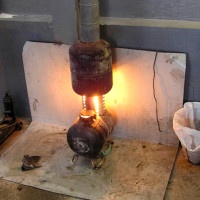 The furnace for working out of the pipe: how to make an effective furnace for used oil from improvised materials
The furnace for working out of the pipe: how to make an effective furnace for used oil from improvised materials 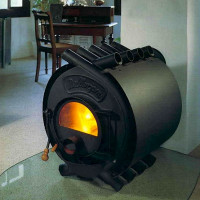 How to make a Buleryan oven with your own hands: step-by-step instructions on how to make
How to make a Buleryan oven with your own hands: step-by-step instructions on how to make 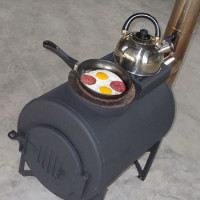 Do-it-yourself stove stove: a scheme of a home-made stove for a summer house and garage
Do-it-yourself stove stove: a scheme of a home-made stove for a summer house and garage 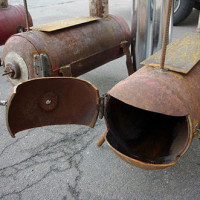 Do-it-yourself gas stove from a gas cylinder: diagrams, drawings + step-by-step guide
Do-it-yourself gas stove from a gas cylinder: diagrams, drawings + step-by-step guide  How much does it cost to connect gas to a private house: the price of organizing gas supply
How much does it cost to connect gas to a private house: the price of organizing gas supply  The best washing machines with dryer: model rating and customer tips
The best washing machines with dryer: model rating and customer tips  What is the color temperature of light and the nuances of choosing the temperature of the lamps to suit your needs
What is the color temperature of light and the nuances of choosing the temperature of the lamps to suit your needs  Replacement of a geyser in an apartment: replacement paperwork + basic norms and requirements
Replacement of a geyser in an apartment: replacement paperwork + basic norms and requirements
I advise you to think twice before making a stove-potbelly stove in waste oil. It is not worth saving such risks. Very fire hazardous stove. Once an impurity of water or antifreeze appears in the oil, it begins to boil and spray outside the stove in a burning state. If it is impatient, then do at least a closed type. Well, if you do not pay attention to danger and non-environmental friendliness, then it drowns well, this cannot be taken away from it.
Do not write nonsense. A used potbelly stove is not much more dangerous than ordinary oil. You just need to observe basic precautions - do not fill in more than 2/3 of the volume so that the oil does not splash out and clean it regularly.
In my opinion, the most optimal option for the manufacture of this type of potbelly stove is an empty gas cylinder. This one I have in the country. A gas cylinder is ideally suited for these purposes with its shapes, and its walls, which are able to withstand high gas pressure, will reliably serve as a heating element. They are not at all afraid, as it seems to me, of a high-temperature thermal effect. As for the fact that the stove-potbelly stove on waste oil is fire hazard, I completely disagree. Especially if you use oil from a certified manufacturer. Moreover, products from responsible companies are now inexpensive.